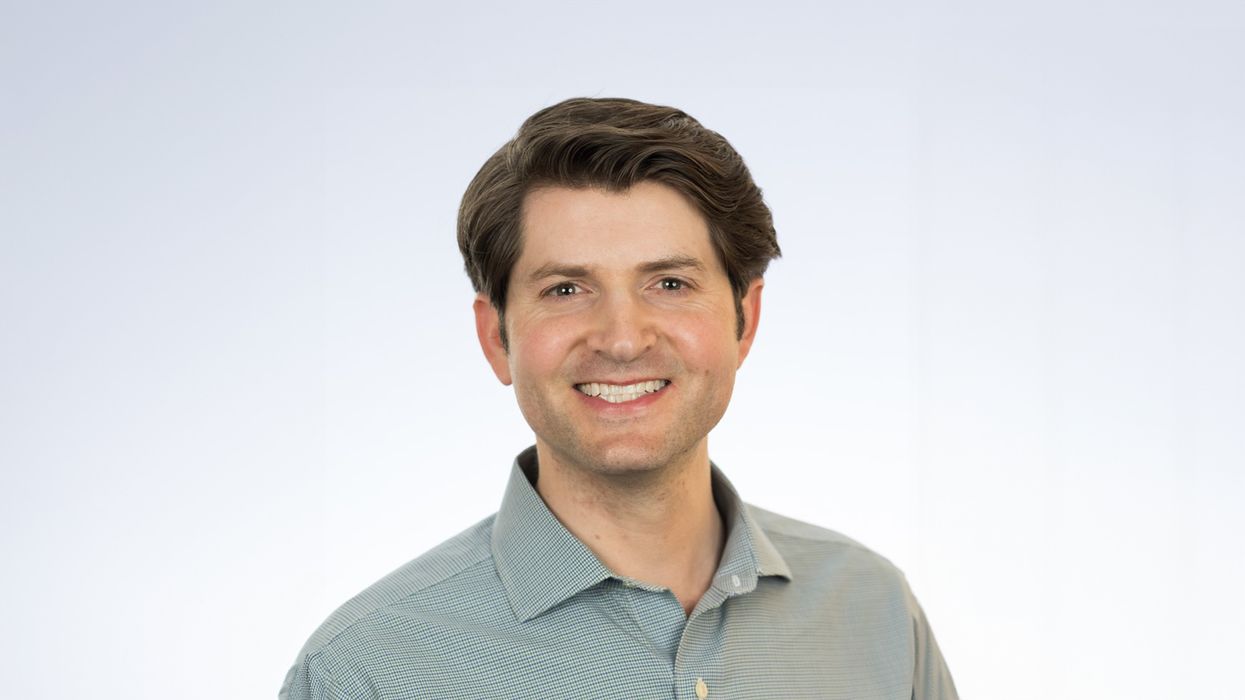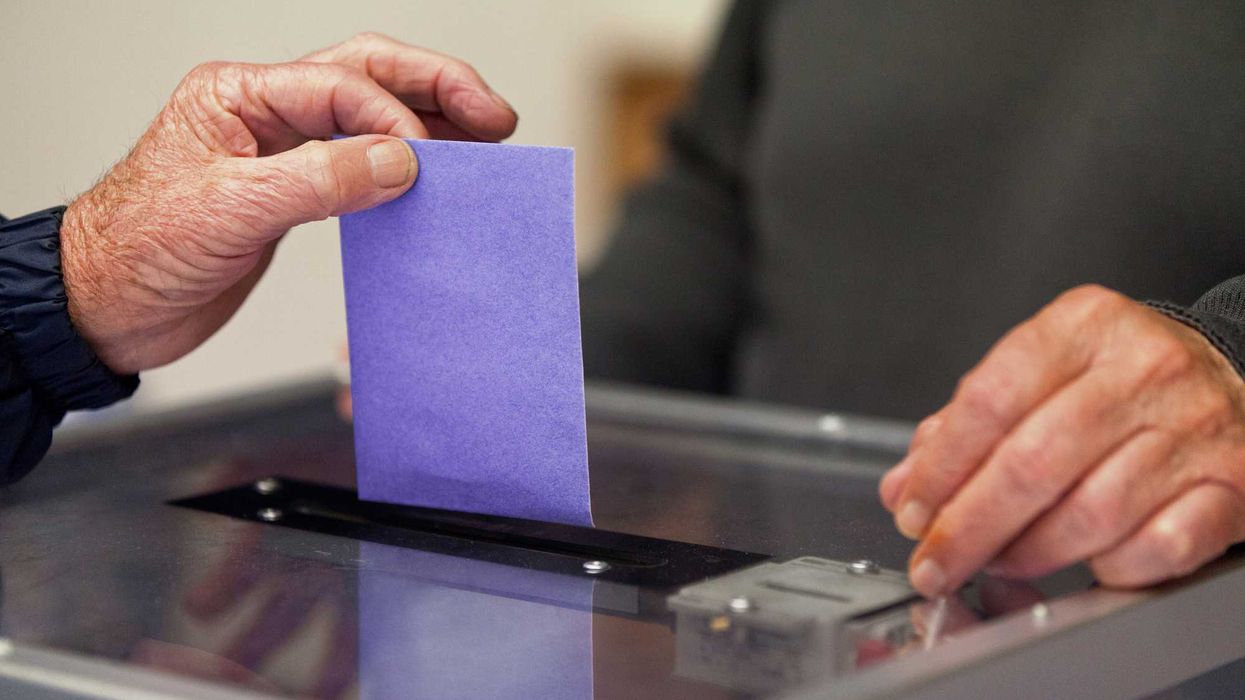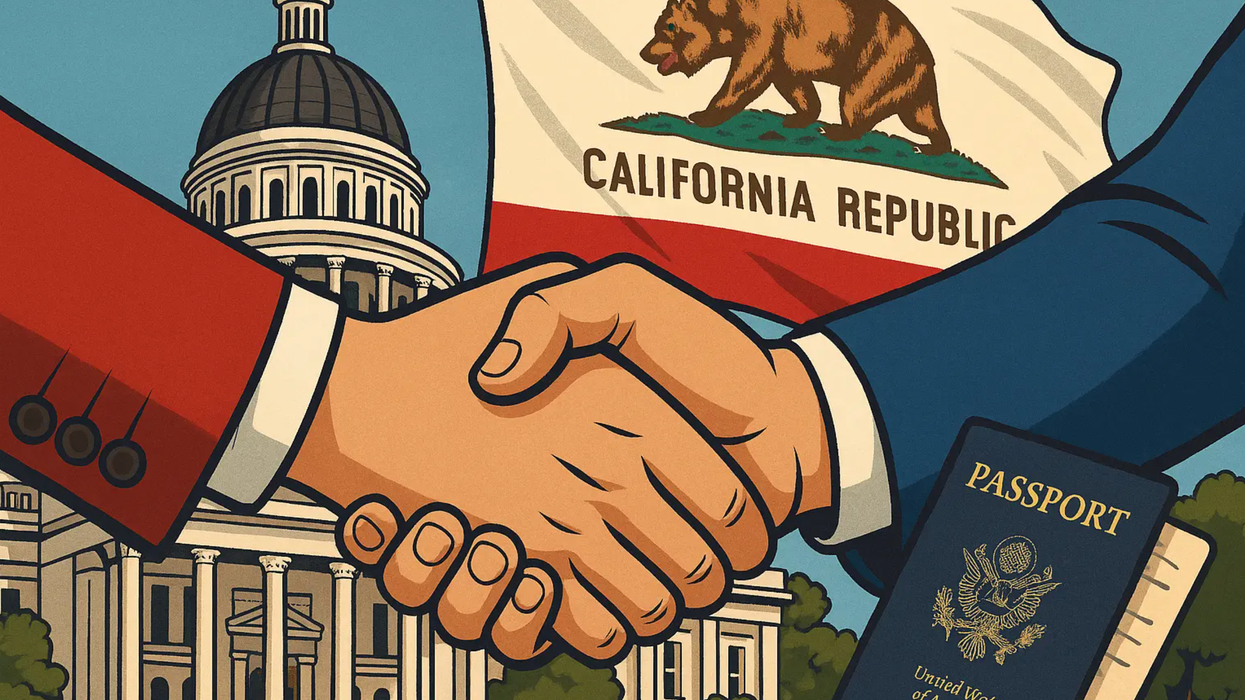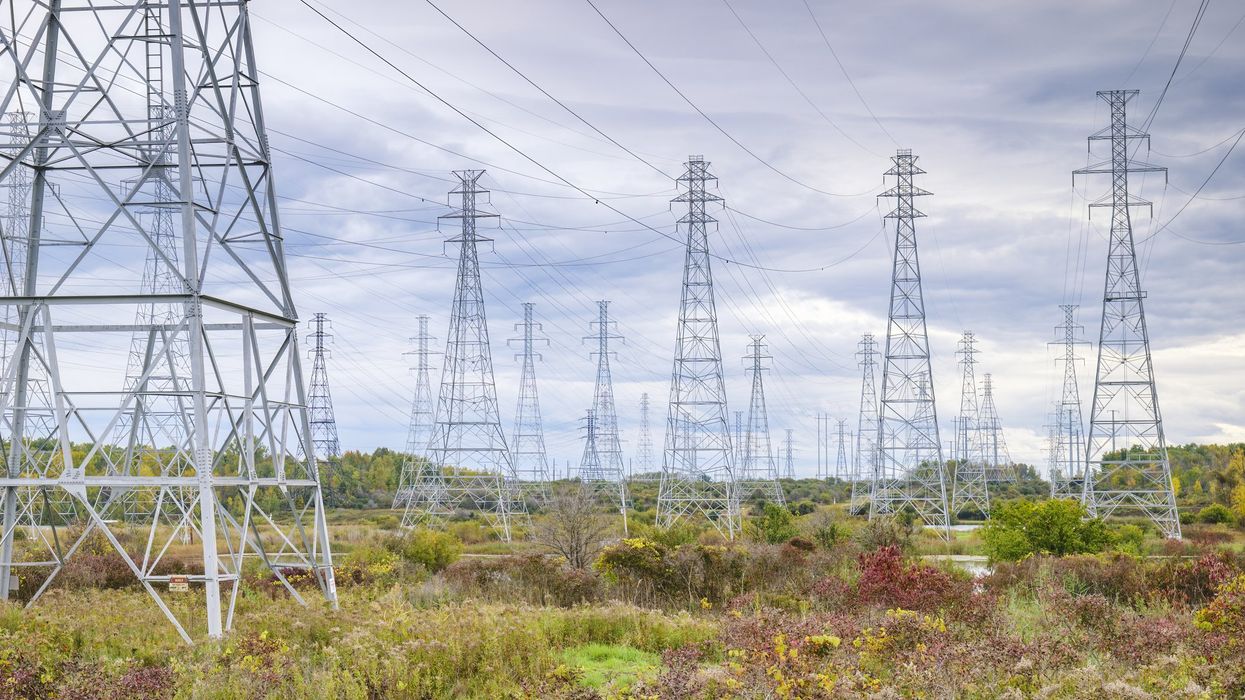Berman is a distinguished fellow of practice at The Harry Frank Guggenheim Foundation, co-editor of Vital City, and co-author of "Gradual: The Case for Incremental Change in a Radical Age." This is the second in a series of interviews titled "The Polarization Project."
The headline of a recent Reuters special report tells a depressing story: “Political Violence in Polarized US at Its Worst since 1970s.” According to the report,
“Explanations for today’s violence vary, ranging from widespread financial anxiety and the upheaval of the COVID-19 pandemic to unease at America’s changing racial and ethnic demographics and a coarsening of political rhetoric in the Trump era. Traditional divisions, typically rooted in policy differences between right and left, have given way to a perception that members of the opposing political party are an evil force bent on destroying America’s social and cultural fabric.”
More in Common, an international nonprofit organization, has devoted a significant amount of intellectual energy to exploring public perceptions about our political divisions. It is perhaps best known for its Hidden Tribes project, which is based on a survey it completed with more than 8,000 Americans.
Based on responses to a range of questions about their moral beliefs and values, the Hidden Tribes report sorted Americans into seven “tribes”: Progressive Activists, Traditional Liberals, Passive Liberals, Politically Disengaged, Moderates, Traditional Conservatives, and Devoted Conservatives. The report went on to argue that the bulk of Americans (everyone but the most extreme partisans) comprise an “exhausted majority.” According to More in Common, the exhausted majority are “fed up by America’s polarization. They know we have more in common than that which divides us: our belief in freedom, equality, and the pursuit of the American dream. They share a deep sense of gratitude that they are citizens of the United States. They want to move past our differences.”
The Hidden Tribes survey, and the idea that perhaps Americans are not as divided as they might seem, received significant media attention, including prominent pieces in the New Yorker and New York Times. To learn more about the research, Greg Berman, the Harry Frank Guggenheim Foundation’s distinguished fellow of practice, talked to Dan Vallone, who at the time was the director of More in Common USA. This transcript of their conversation has been edited for length and clarity.
Greg Berman: I must confess to some ambivalence about the topic of polarization. On the one hand, I spend time online, and when I do, I tend to find things that concern me. For example, the polarized reactions to COVID and January 6 were deeply upsetting. But then I go out into the world and it doesn't feel like we're on the brink of civil war when I walk the streets. So I'm kind of curious to hear your take: How big a problem do you think polarization is in the US at the moment?
Dan Vallone: I kind of agree with how you have framed it. The impact of polarization is sometimes dramatically overstated. For example, we did a study before the 2020 election. We gave Democrats and Republicans two scenarios. One was a scenario where Biden was perceived to win the election, but Trump challenges it. With that framing, we asked Republicans, "Which of the following actions would you condone?" And we gave them a scale of actions that ended with physical violence. And similarly, with the Democrats, we presented a scenario where Trump was perceived to win, but Biden was claiming that the election was lacking in integrity. We asked them the same question: “Which of the following actions would you condone in this scenario?”
We then asked both Republicans and Democrats to assess what the other side would condone. So basically, we asked the Democrats, what proportion of Republicans would condone violence in a scenario where Biden is perceived to have won the election, but Trump is claiming it was stolen? And we asked Republicans the same basic question in a scenario where Trump was perceived to have won the election, but Biden claimed it was stolen.
What we found was that, among both Republicans and Democrats, only 3 or 4 percent actually said that it was permissible to conduct physical violence. But both Democrats and Republicans thought that 50 percent of the other side would condone physical violence. So we have this very distorted picture of our political opponents. In that context, polarization itself is not anywhere near as bad as we think it is.
So I would actually agree that some of this is a dramatic misperception that we have about contemporary dynamics in American society. At the same time, those very dynamics make our politics toxic and make it so much harder to pass meaningful legislation to address challenges, even where there's broad support. It normalizes any number of negative behaviors and actions. There has been a spike in hate crimes and online activity that is coinciding with this worsening affective polarization. It is hard to prove causality, but it is worth looking at pretty seriously. The rise in dehumanization is very alarming.
GB: I first heard of More in Common when you released the Hidden Tribes research. One of the things that I appreciated about that project was that it seemed like an effort to move the conversation away from a binary, left-versus-right dynamic, where there's only two sides to every issue. You were taking a more granular look at what the American public believes. And one of the things that stood out was the fact that most Americans were not die-hard progressives or die-hard conservatives. The term you used to describe the bulk of the American electorate was “the exhausted majority.” What did you mean by this?
DV: The way that we produced that segmentation was via a cluster analysis. We asked respondents a large battery of survey questions that drew on findings from social psychology. For example, we leaned on the moral foundations theory that folks like Jonathan Haidt have done a lot of work to build out. We asked a battery of questions about people’s identities and how they understand those identities, including race, gender, ideology, faith, etc. To your point, we were really trying to understand at a much more granular level, how are Americans feeling in the moment? And then we wanted to categorize them based more on their values than on their demographics.
So the exhausted majority are different from what we call the wings on several levels. First of all, they are much less engaged in political behavior outside of voting. So the exhausted majority are much less likely to post political content online. They're much less likely to give money to political candidates. Their level of engagement in politics is dramatically less than the progressive activists on the left or the devoted conservatives on the right. And related to that, they also feel left out of the political conversation. So folks in the exhausted majority are much more likely to say things like, “I don't feel like my viewpoint is reflected in the political discourse.”
The other way in which the exhausted majority are different from the wing segments is they are much more prone to support compromise and moderation. We asked the survey respondents about whether political actors that represent your views should do more to compromise with the other side versus stick it out and fight. The exhausted majority are much more prone to see compromise as a valuable asset as opposed to the wings. The exhausted majority are literally exhausted by the divisiveness in our politics. The folks in the wing segments, the progressive activists and the devoted conservatives, don't love division for the sake of division, but they do see it as a necessary part of winning.
GB: In conducting research for the book on incrementalism that I co-wrote with Aubrey Fox, I looked at a lot of public opinion polling. And one of the things that stood out for me was that, even on contentious issues like abortion or policing or guns, you could actually identify pretty broad public support for a range of reforms. If that’s true, and if you are right that the bulk of American voters are not at the wings, why have our political parties and our political discourse gone to the extremes in recent years?
DV: There's pretty credible data showing that the largest proportion of Americans identify as moderates. And the proportion identifying as independents has actually been growing. The reality is that, on so many levels, Americans do actually share a lot in common. So why does that not show up in our politics? I think different folks would advance different reasons. At More in Common, we don't actually have a particular viewpoint on this. I think one factor that I would point to as being very salient is the media information ecosystem in the US, which is dramatically more fractured than most of its peer nations. In the US, it is possible not just to have competing explanations of what's happening in the country, but actually coexisting realities. There's less and less overlap in the information that people consume, so we have a harder time actually arriving at a shared sense of what the challenges are and what the priorities should be. That's a big one.
The second thing a lot of folks I think rightfully point to is the dynamics of the two-party system. Here, I think my point of view is a little bit more cautious about the degree to which purely structural factors in terms of how our elections are run contribute to toxic polarization. And the reason I’m a little bit cautious is that our colleagues in Europe work in countries that have parliamentary systems and multi-party systems. And even there—in France, for example—we see very dramatic shifts in polarization happening. Having said that, it is valid to look at the degree to which a minority group within either the Democrats or the Republicans can dominate because things are so gerrymandered that the primary has become more important than the general election in any number of settings.
And then the last thing I’d point to—and I think this is a little bit under-covered, to be totally honest—is that there has been a decades-long shift in terms of civic infrastructure in the country. What I mean by civic infrastructure is the settings within which people do public problem-solving across lines of difference. There are fewer and fewer organizations or settings where Americans feel a sense of membership, where that membership involves some sort of agency in solving public problems at the local level. Increasingly, people's engagement with politics is that they're giving money or they're responding to national organizations that are typically led by well-educated folks. That hollows out a lot of our civic infrastructure and contributes to the nationalization of everything. We lack sufficient, healthy, collective settings where people can actually learn to do democracy together.
GB: It sounds like you are echoing Robert Putnam’s “ Bowling Alone ” argument.
DV: I think that Putnam emphasizes social relationships and social capital, which is really important. We would also say that an important part of social connection is actually being involved in collaborative problem-solving. Pluralism is, in many ways, a learned value and norm. It's also a byproduct of doing problem-solving where you have to compromise with people with different backgrounds, where you have to realize that the democratic process can produce better outcomes even if, in some instances, your side loses. We have fewer and fewer spaces where people actually do that kind of work. We've allowed more of those kinds of efforts to be dominated by, again, national organizations that are more transactional in how they engage most Americans.
GB: I’m old enough to remember the old Tip O’Neill bromide that all politics is local. It feels like that’s been turned on its head and now all politics is national. But I guess I don't see a pathway to undoing that, given the realities of the internet.
DV: Our society is changing not just demographically, but also we're learning new ways of engaging with each other. The internet, Zoom, all of that. We've gone through enormous change over the last three decades. We have to figure out new ways of engaging with each other in civil society and in politics.
One of the challenges we face is the erosion of important institutions. People are attacking institutions and no one's defending them. At the same time, even as we see institutions being eroded, new institutions are being created. There are, I think, a lot of good things happening that are sometimes hard to see. I don't necessarily think that we need to do some kind of revolutionary transition from the nationalization of everything to the localization of everything. I think much of the work is already underway. It would be great if we could accelerate that and if we could convince more Americans that this is actually happening.
GB: You mentioned the erosion of institutions. As someone who cares about the health of American institutions, I've found the last couple of years destabilizing. It seems like many of our institutions have been stress-tested and been found wanting. You have written in the past about public perceptions of the military. How much do you worry about the politicization of institutions that have gotten dragged into the culture wars?
DV: Working at More in Common has underscored for me the critical importance that institutions have in actually ensuring a healthy, vibrant, and inclusive democracy. So we need to make sure that we have institutions that work. I'm definitely concerned about the potential politicization of institutions.
We see this playing out in the military. Although we should also be wary of hyping up the degree to which people are polarizing in their views towards the military. I think it was Gallup who did a poll that saw a noticeable drop in the percentage of Americans who said they had a great deal of confidence in the military. At More in Common, we do research on this, and we also saw a slight drop. I think at most we're talking ten points, which is meaningful, but this should be viewed in context. The confidence level in the military is still 70 percent or higher, which is very high relative to many other institutions.
So it's important to pay attention to any shift in confidence, but at the same time, we have to recognize that public confidence in the armed services is still an incredible strength. The question is: How do we further bolster the strength? The first thing we have to do is avoid the tendency to overreact, which causes people to do, perhaps, unconstructive things because they're responding to a misperception. So job one is really grounding ourselves in the data around what people feel towards institutions and not allowing false impressions in the media to drive our behavior.
Number two, I think all institutions—whether it's schools, whether it's media, whether it's government, etc.—need to be doing a lot more to build relationships physically. We tend to focus a lot on the internet because that's where relational dynamics are moving, but there's still an incredible amount that happens in person. One of the major issues is the distribution and accessibility of military bases, for example. Military bases tend to be concentrated in the Southeast, and they're very hard to get onto because of security concerns. This has contributed to a huge dearth of relationships between many segments of the society and the military. Recruitment is increasingly looking like a family affair, where it is primarily people who have immediate family members currently in the military who are signing up. Long term, that's really not healthy for the institution. So how can the military change its footprint so that more and more Americans have some sort of physical engagement with the institution?
I think the same thing applies to other institutions. A lot of the negative dynamics that we see with regard to polarization of school boards would be mitigated if there was greater connectivity between schools and parents and community groups. People feel very disconnected from many government institutions. And I think the prevailing paradigm has been that if we just improved the efficacy of the services we deliver, that that will resolve the problem. But what we really need is more membership. We need people to actually feel a sense of belonging and connection to government, which means not just trying to toggle the interventions you're delivering, but actually going out and building relationships. It's hard work. It takes a lot of time and a lot of resources to connect with people.
GB: Vox did a critical piece on your Hidden Tribes research when it came out. One of its criticisms was that you were essentially engaging in what is sometimes known as “ both-sides-ism,” placing blame equally on the left and the right. Many of my progressive friends argue that this is a trap and that the right is really much more to blame for the polarized situation we find ourselves in today than the left is. I'm wondering how you would respond to that critique.
DV: What I would hope people take away from our work is that the two-side paradigm is just wrong and a huge constraint to understanding both the problems we're facing and the potential solutions to make things better. There are many different ways in which actors across the political spectrum are contributing to polarization. It’s less about which side is doing what and more about figuring out ways to reduce our own individual and institutional contribution to the polarization that is harming all of us.
I think getting away from the both-sides dynamic would improve our diagnostic capability to try and really understand what's happening within specific institutional settings. The more that we have this binary framework locked in, the more we concede ground to what Amanda Ripley calls “ conflict entrepreneurs” —the folks who are actively trying to divide us, trying to sow division mostly to make money.
GB: At the start, you talked about the gap between how Democrats perceive Republicans and the reality of the views that Republicans actually hold, and vice versa. One of the depressing findings from your work on the perception gap is that education and media consumption don't actually help to ameliorate the gap.
DV: The dynamic that we discovered was particularly true for liberals and education—the best-educated liberals had the highest perception gap. And similarly, media consumption didn't necessarily reduce perception gaps to a meaningful degree across the board. Diversity of social relationships was correlated with lower perception gaps. So the more friendships you have with folks who have different ideological backgrounds, the better in terms of the magnitude of your perception gap.
GB: I want to turn to the question of what is to be done. Earlier, you expressed some skepticism about systemic changes, like gerrymandering reform. I must confess to some skepticism about individual-level reforms. I am skeptical that getting people together to hash out their differences is a meaningful intervention, or can be done at the kind of scale that is necessary to make a difference. If you were a funder, where would you be investing your money if the goal was to reduce affective polarization?
DV: We need a diversity of approaches. So if I were advising funders, I would tell them to take the portfolio approach. There’s definitely a place for structural reform. I think that I'm more cautious than skeptical about this approach. It would be great to see new innovations in terms of how we think about political engagement and how we run elections. I just would be cautious about the degree to which those changes will dramatically reduce polarization. I would put more energy behind engaging more people in the process. I think the depth and diversity of the folks that you engage in whatever movement you're doing matters a lot more than the specific intervention that you produce.
A lot of the individual depolarization interventions are well done. These spaces are incredibly warm and welcoming. But there are a lot of issues with who shows up to those kinds of events. Selection bias is pretty hard to eliminate. There are also issues of scalability.
I think the institutional setting is still dramatically under-leveraged by a lot of philanthropic actors and by a lot of other folks who are concerned about polarization. I think about work being done on college campuses right now by folks like BridgeUSA to try to foster healthy exchange of ideas, both among students but also across students, faculty, and other personnel on the campus. I would also point to One America Movement, which works primarily within churches, temples, and mosques to create institutional cultures that are able to engage healthily on polarizing topics. There's a group called We the Veterans that's trying to figure out how to bring together the veteran community.
One of the challenges with this kind of work is that it is less easily measured using randomized controlled trials. It is also less likely to result in a clear policy victory at a local, state, or federal level. These kinds of interventions are seeking cultural change. They're about norm shifting. They're about bringing new actors into civic spaces. And those changes are just much harder to measure with the kind of rigorous models that have become very prevalent in social science.
GB: We're heading into presidential election season, which is typically a time when our divisions are heightened. I'm wondering how optimistic or pessimistic you're feeling about polarization as you look to the next couple of years.
DV: I'm optimistic. I'm more optimistic than I was three years ago. More and more, you see folks across the ideological spectrum cautioning us about the dangers of hyperpolarization. Without converging around some sort of mushy middle or centrism, lots of people are articulating that we need to have a more positive vision for the country. So I think that what we will see in 2024 will be many things, some of which will be hyperpolarizing, but also we'll see really prominent actors across the ideological spectrum espousing pretty positive visions for the country and positive visions for how we relate to one another. We need to take seriously all of the risks that were present in 2020 and continue to work on mitigating against the degree to which polarization translates into actual violence.
The 250th anniversary of the country is coming up in 2026. I think that’s a really significant opportunity. As we honor this anniversary, we can have a vibrant and positive experience celebrating a story of progress. It is a chance to acknowledge our imperfections and flaws, but also honor the positive arc this country has gone through.
This article was first published by the Harry Frank Guggenheim Foundation and has been republished with permission.




















